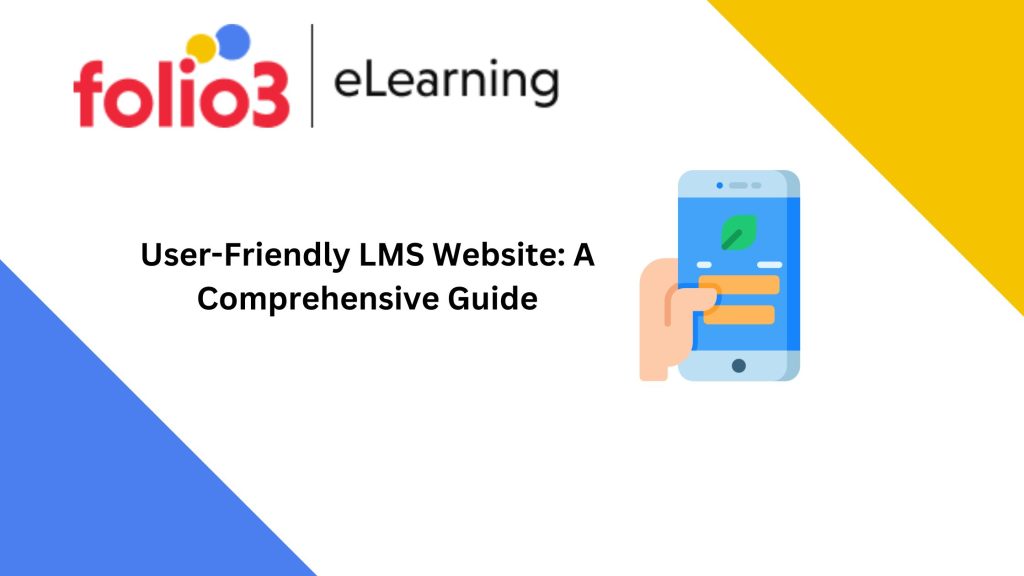
Executive Summary:
Learn how to create a seamless online learning experience with a user-friendly LMS for a website supported by a reliable LMS development company, from easy navigation to dynamic material.
Introduction:
The importance of online learning has grown in the ever-changing world of education. Learning management systems (LMS) have enabled educational institutions, companies, and people to provide scalable, structured courses to a global audience.
But to fully realize an LMS’s potential, it is essential to create a user-friendly platform that makes learning more accessible and keeps learners interested.
This thorough guide describes the essential steps to building an engaging and intuitive LMS website, guaranteeing a flawless user experience.

Designing a User-Friendly LMS Website:
Here are some guidelines that you can follow to create a user-friendly LMS for a website:
- Understanding the Importance of a Website’s User-Friendly LMS:
Understanding the profound significance of a User-Friendly LMS for a website emerges as a cornerstone for effective and impactful learning experiences in the rapidly changing educational landscape, where online learning has become integral to knowledge dissemination.
This significance is rooted in the fundamental idea of streamlining the educational process, where a user-friendly learning management system (LMS) orchestrates an easy-to-use interface that guides students through their educational journeys regardless of their technological proficiency.
Beyond simple navigational convenience, a user-friendly LMS extends its significance to actively promote strong learner engagement by strategically integrating interactive elements like discussion boards, live chats, and collaborative projects, fostering a sense of community, knowledge sharing, and participation.
- Navigating the Fundamentals of LMS Design
A purposeful synthesis of art and utility is required to begin the challenging road of LMS design, where the orchestration of User Interface (UI) and User Experience (UX) aspects becomes crucial. To create a seamless information architecture for navigation, content, modules, and tools must be arranged logically so that users can follow a clear path.
While a comprehensive UX strategy prioritizes user demands, assuring consistency, accessibility, and satisfaction across all touchpoints, a harmonious UI thrives on simplicity, combining clear menus, responsive buttons, and unified aesthetic components to promote simple interaction.
The foundation of responsiveness guarantees adaptation across all devices, spanning screen sizes and device types, ensuring accessibility and engagement for all users.
- Creating Interesting Content to Promote Learning
In the context of learning management system (LMS) design, creating engaging content requires a skillful combination of pedagogical knowledge and multimedia innovation. It involves the thoughtfully planned strategic blending of various information types, such as videos, tests, interactive projects, and discussion forums, to catch learners’ interest and energize their learning process.
While interactive quizzes test and strengthen information retention, visual storytelling in the form of movies helps topics come to life and promote deeper comprehension. Encouraging learners to interact and investigate real-world events actively, engaging assignments encourage critical thinking and the application of knowledge.
Discussion boards encourage group learning by enabling students to share knowledge, debate concepts, and co-create new knowledge.
- Gamification as a Tool to Increase Engagement
A powerful technique to increase learner engagement and motivation is to use gamification within the context of Learning Management Systems (LMS). Gamification turns the learning process into an interactive and dynamic experience by including game design elements like points, badges, leaderboards, and challenges.
Learners are encouraged to complete goals, earn rewards, and participate in competitions to develop a sense of accomplishment and healthy competitiveness. Gamified progress tracking gives learners a sense of purpose and encourages them to develop and achieve goals.
Additionally, the challenge factor fosters cognitive engagement and problem-solving abilities, successfully transforming learning into an exhilarating adventure.
- Collaborating with a Skilled LMS Development Company
The construction of a strong and user-friendly Learning Management System (LMS) is supported by a strategic imperative that calls for collaboration with an experienced LMS development business.
Such collaboration ensures the LMS is constructed on a firm foundation by bringing knowledge, technological prowess, and industry insights to the fore. The entire lifespan, from conception and design to implementation and continuing support, is supervised by a knowledgeable LMS development company.
They create an intuitive user experience that aligns with the most recent technical developments by seamlessly integrating cutting-edge features, fluid user interfaces, and strong security measures.
- Adaptability and Personalization for Diverse Learners
A User-Friendly LMS for websites that incorporates customization and adaptability enhances the learning experience by catering to the various LMS demands of each individual. Each learner’s experience is distinct and aligned with their goals, thanks to the User-Friendly LMS’s customizable learning paths, adaptive assessments, and personalized content recommendations.
A flexible structure that seamlessly incorporates various learning styles and skills enables learners to interact with the content at their own speed. Continuous improvement is encouraged through adaptive exams, which intelligently assess individual competence levels, provide focused feedback, and dynamically adjust the difficulty.
By enhancing accessibility with features like closed captioning, language selection, and user-friendly interfaces, the User-Friendly LMS embraces diversity and ensures that every learner using the website has an enhanced and personalized educational experience.
- Continuous Development and User Feedback
Creating a user-friendly LMS for a website involves a continual dedication to excellence, propelled by ongoing user input and continuous development. The LMS can adapt to changing educational dynamics and student preferences thanks to this iterative approach.
Regularly asking for and incorporating user feedback creates a mutually beneficial relationship that enables the LMS to address user needs, improve functionality, and better meet user expectations.
The User-Friendly LMS for a website transforms into a dynamic and adaptable platform by adopting a culture of continuous improvement, ensuring that the learning experience remains pertinent, interesting, and sensitive to the constantly changing demands of students, teachers, and administrators within the website’s ecosystem.
Conclusion:
Developing a user-friendly Learning Management System (LMS) for a website is a monument to the transformative potential of technology in the dynamic world of digital education, where the pursuit of knowledge transcends conventional bounds.
As we come to the end of our exploration of the subtleties of LMS design, it is clear that the synthesis of user-friendly navigation, interesting material, adaptable features, and ongoing refinement produces a welcoming and enriching educational ecosystem.
An easy-to-use LMS transforms into more than just a platform; it transforms into a portal to limitless learning opportunities, a world where students discover, teachers inspire, and administrators empower.

FAQS
Personalized learning paths, proficiency-based examinations, and content recommendations are all made possible by personalization in an LMS. This strategy caters to various learning styles and aptitudes, creating a more inclusive and productive learning environment.
Constantly ask for customer feedback, examine usage trends, and release updates regularly depending on your findings. Thanks to this iterative approach, your user-friendly LMS will continue to align with changing learner preferences and technological improvements.
By giving students a simple, engaging platform that simplifies learning, encourages active involvement, and embraces personalized, interactive, and flexible features, a user-friendly LMS enhances online education and improves the entire learning experience.
Focus on intuitive navigation, responsive UI/UX design, a variety of multimedia content, the addition of gamification components, personalization possibilities, and cooperation with an experienced LMS development business to build an engaging LMS design.
If your LMS is responsively designed, it will automatically adjust to various screen sizes and types, giving consumers a consistent and usable experience whether they access the platform from a desktop, laptop, tablet, or smartphone.










